I really didn’t want to write this post as anything other than a straight update and technique post. But I seem to have not only thrown a rock at a hornets nest, but I’ve knocked it down and danced naked on top of it, twerking for the target practice of the hornets.
Great image, right? A big, white ass riddled with livid red welts being swarmed by angry hornets.
My last post has, shall we say, enlivened the debate about how we, as a bonsai community, have been treating newcomers.
I showed my friend Paul Pikel the Reddit forum for bonsai and all the replies from my last post. It is not an exaggeration to say that he was horrified.
First and foremost, most professional bonsai teachers and artists are willing to share their knowledge with beginners. I have observed this many times and the teaching is done with grace and élan.
Secondly, some experienced bonsai practitioners and growers try to project an air of authority that is off-putting. Some, mind you, not all.
This next part is where I’ll get in trouble. Ready?
The third group are the intermediates. They seem to be the worst offenders when it comes to handling beginners.
The main problem is that these intermediates think they are occupying a higher pay-grade than they really are. It’s human nature.
This is really going to sting but…..I don’t care how long or how little you’ve been in bonsai, there are some old timers who’ve been in bonsai for 30 years that are still intermediates and there are some professionals with great art (like Michael Feduccia) who can count on two hands (and still put their pinky out when sipping tea) how long they’ve been practicing the art. Aptitude and attitude counts. It’s a mindset that, even though you can spout out what the C.E.C. of akadama compared to D.E. granules is, or you understand when and how and why to equalize the energy distribution on JBP candles, you still have a lot to learn, that puts you into the advanced category. It’s this knowledge that you don’t have all the answers that makes you more receptive to beginners.
I often categorize myself as a “know-it-all”. I do know a lot, but I realize that I don’t know it all. I probably use reference materials and google searches more than most people because I am unsure of what I know.
Do I consider myself advanced?
I don’t.
Anyone who categorizes themselves as advanced probably isn’t. I’ve done advanced work, I’ve done some small bits of master level work, but I’d consider myself journeyman status. Still seeking knowledge and spreading what I know.
Which brings us to the second theme of this post.
I know, for an absolute fact, that this tree was a “ginseng” ficus.
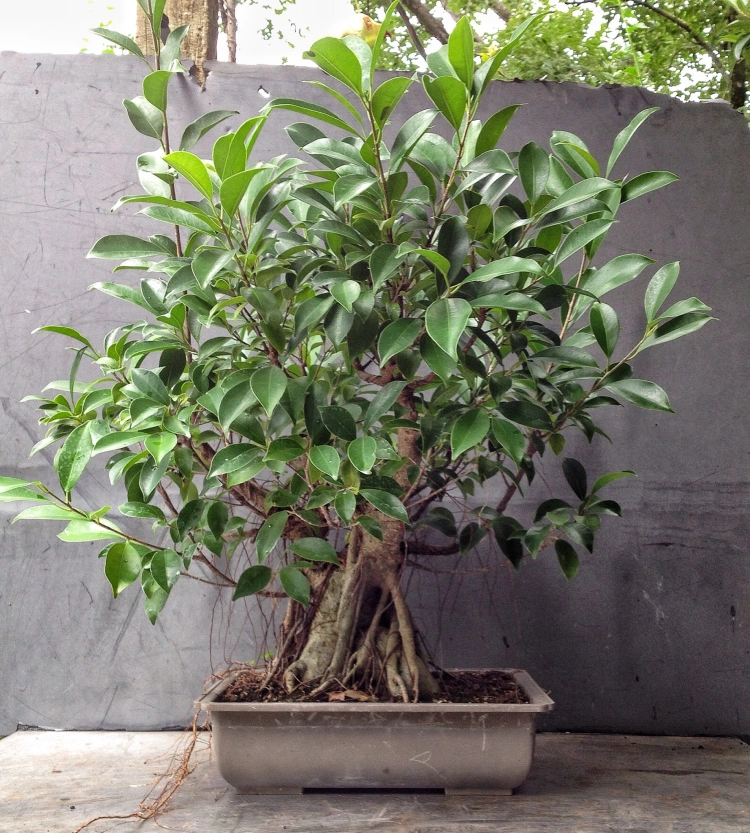
Yes, I am going there again.
Did it start out like this one?
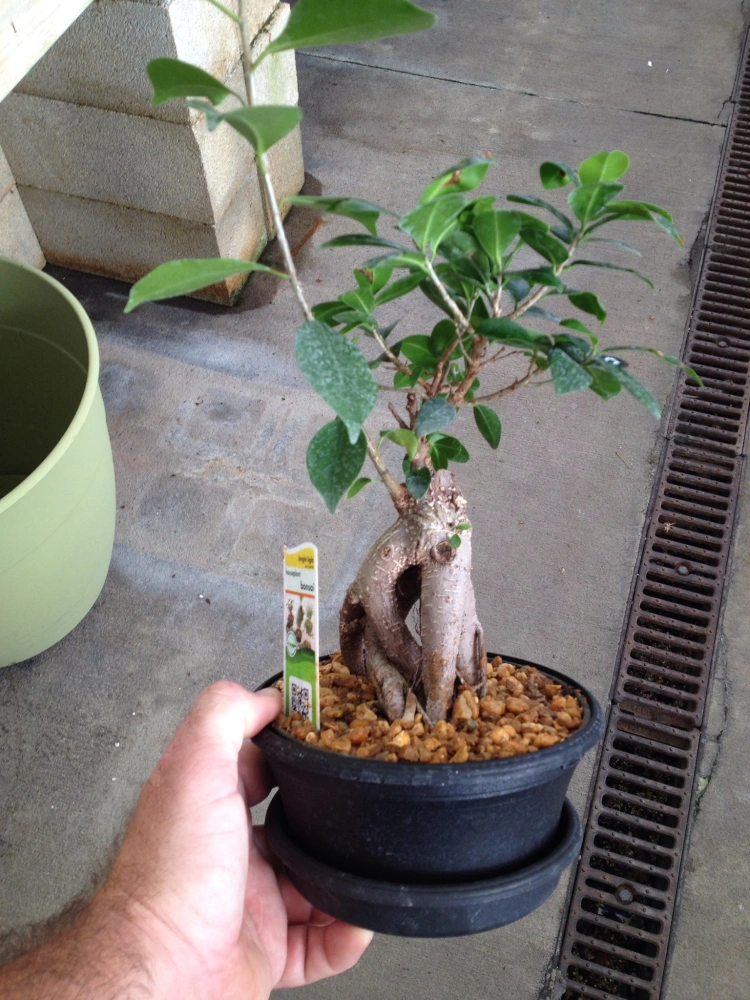
Possibly.
As an aside and a point to be made, the tree just above is an example of a grafted “ginseng” ficus. Which means that the original foliage was replaced with what looks to me to be the “retusa” or “tigerbark” foliage.
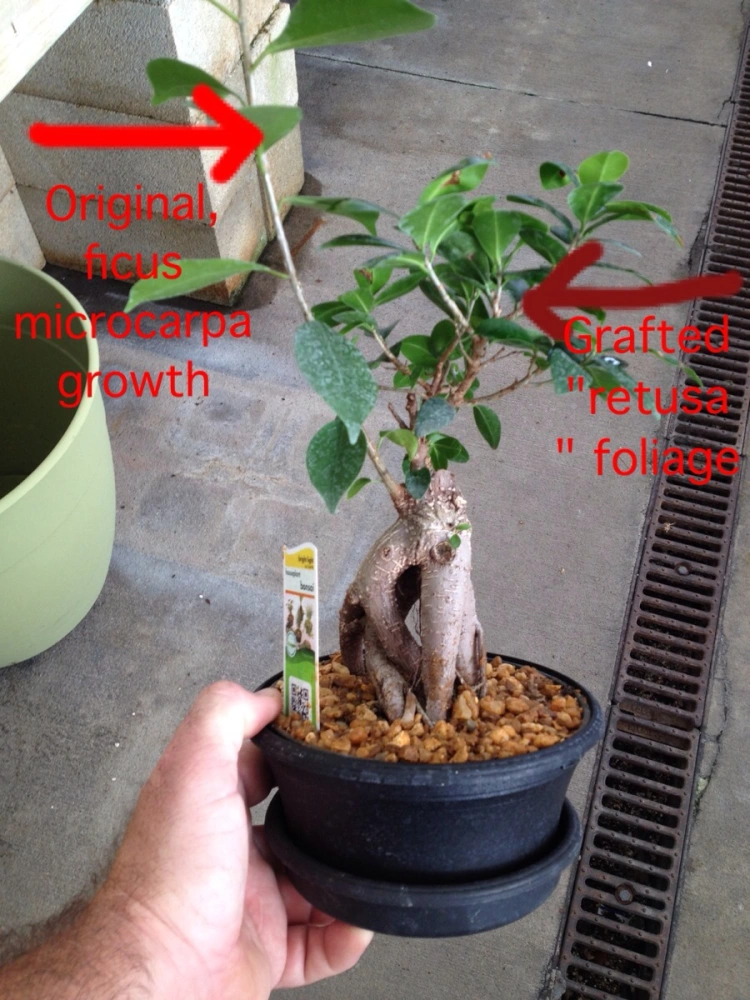
Which answers a question someone had about cutting off the graft and if the original foliage would grow back.
It seems that most people who are anti-ginseng use the phrase “they’re grafted” in a negative way.
Most Japanese pines and junipers are grafted. I have that nugget-of-fact on very high authority.
The grafted ginseng actually have better foliage, retusa or golden coin or some other; dense, close internode, and smaller leaf size. Which makes the grafted easier to develop actually.
And I’ll give you the point that the original, f. microcarpa growth habit is more difficult to work with.
But, if we go back to the black pine example, do you know how hard it is to work on them?
Let me illuminate.
The needles are big.
It has a whorl growth habit.
The bark doesn’t begin to age for ten or more years.
Bud back? Hah! It takes years to ramify a black pine. And only using a specific, timely, and meticulous feeding, pruning, wiring and potting schedule.
And yet! YET! It’s one of the most popular bonsai species.
Oh, did I mention that they’re easy to kill?
And let’s not even talk about junipers.
Maybe a little.
The biggest complaint about the “ginseng” is it’s bulbous, non-treelike trunk.
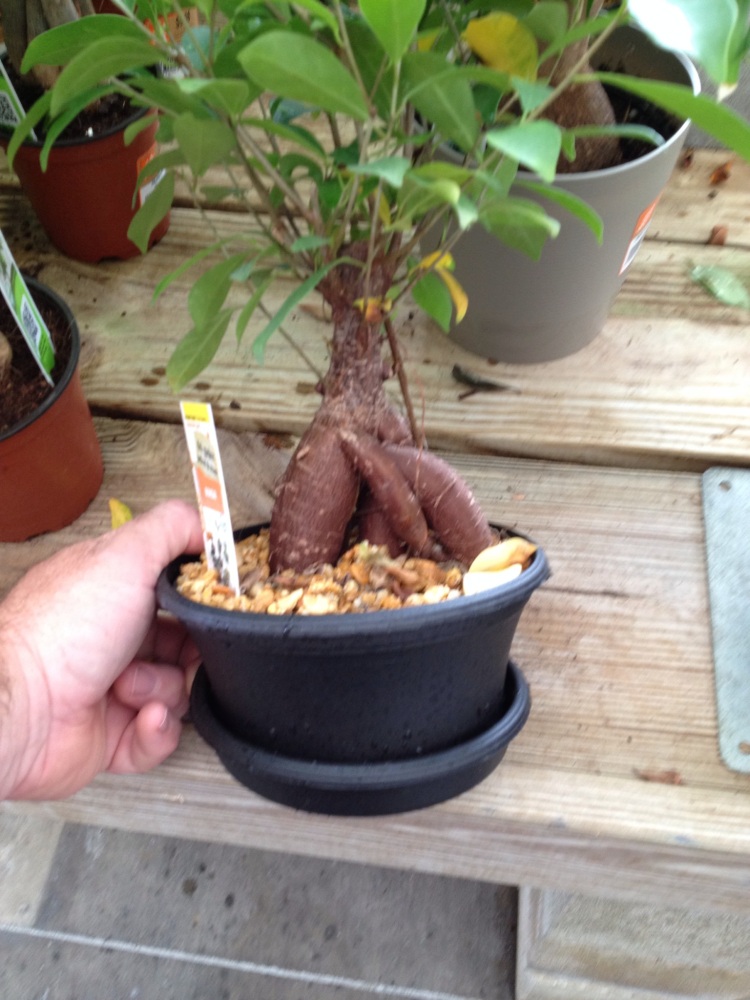
I totally agree.
But I have a few things for you to think about when considering the trunk of the “ginseng”.
The trunk is actually the root system of a seedling ficus microcarpa that has been raised above the soil to give it a fatter trunk. We do that all the time with trees.
They are young plants. If I showed you this young trident:
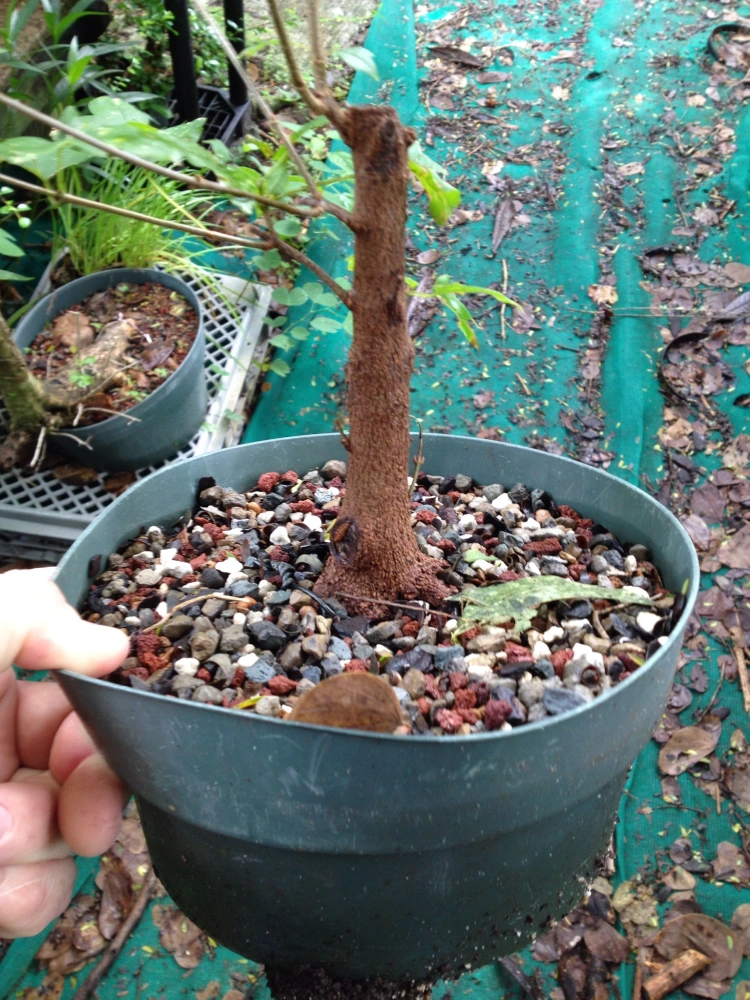
Or this ilex:
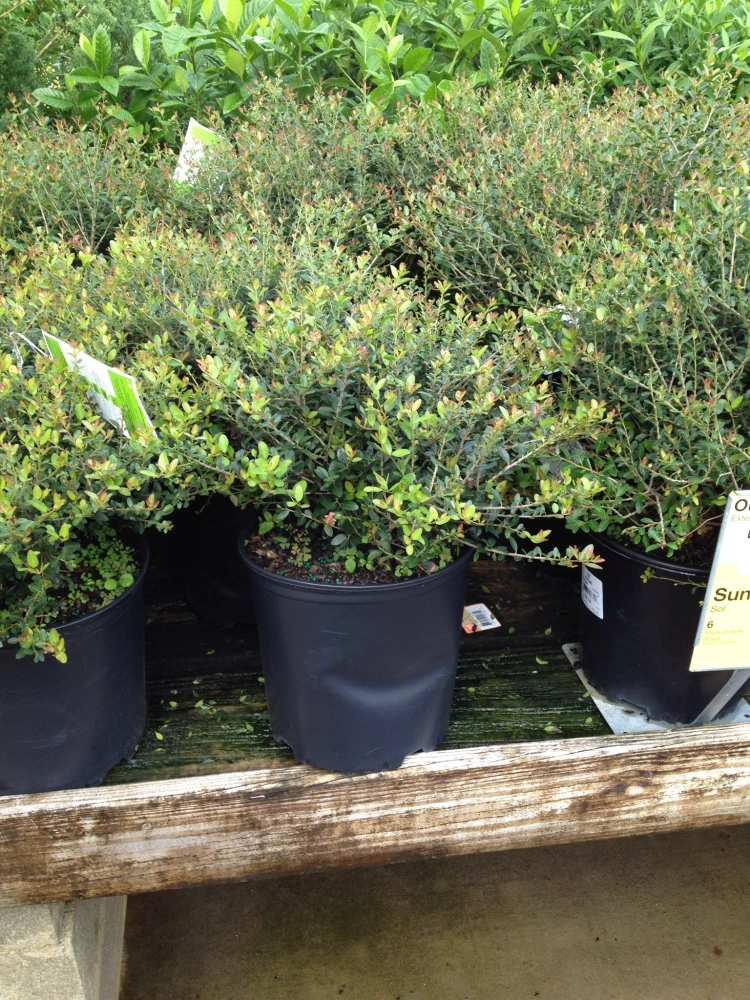
You’d say,
“Oh, that needs about 5 or ten years in the ground before you can even think about it being a bonsai”.
Or if I showed you this Eugenia:
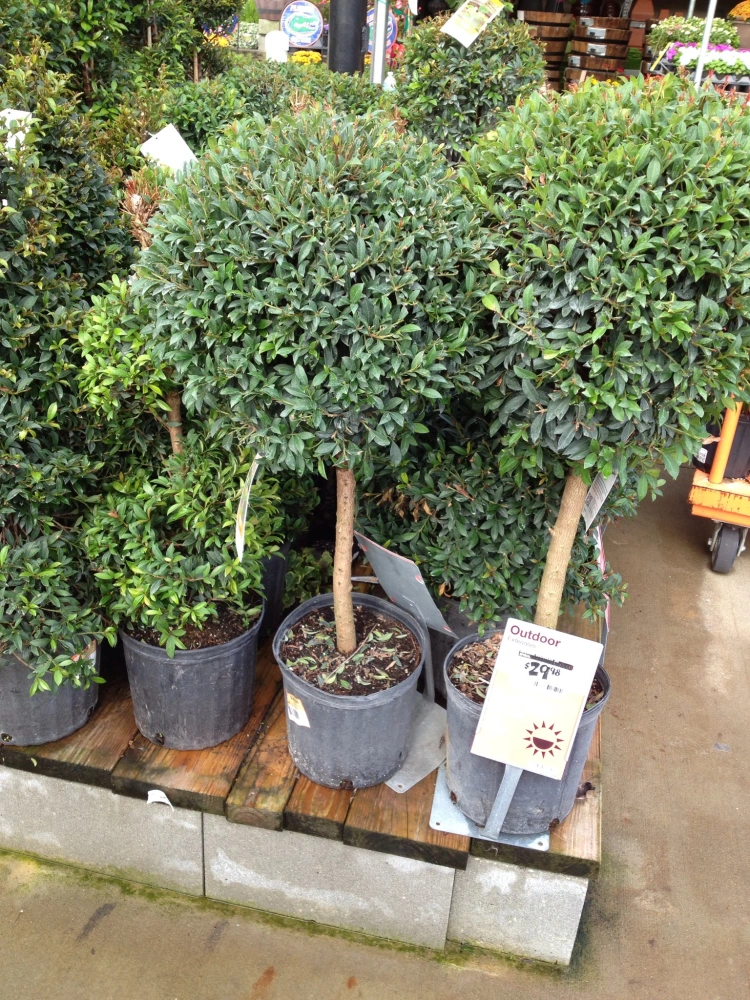
You’d say that it needs a trunk chop.
Which are both valid, constructive pieces of advice.
All bonsai, mine and yours included, need more time.
Shit, there are some of Ryan Neal’s and Ed Trout’s trees that need time.
But I don’t think your gonna say that to their faces now, are you?
You’re afraid of them, but a noob, yeah, they’re easy prey, fresh meat to pick apart.
Especially if they have a ficus.
It’s easy to pick on ficus bonsai.
So, the look of a “ginseng” is offensive, I’ll agree.
Have you seen the twisted shimpaku junipers that have been showing up lately?
Some of them, I’d say about ten percent (yes, that low) look good.
Like this one.
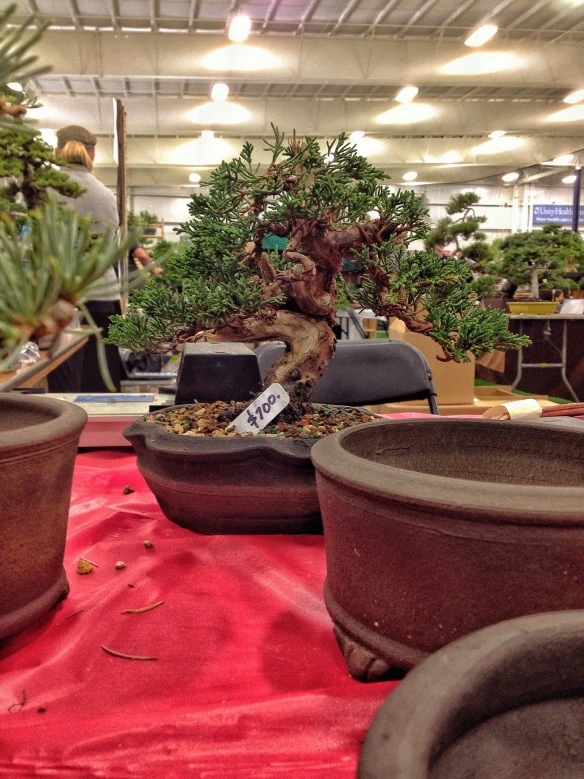
The one above was on Jim Gremel’s sales table at the National Show.
Most look like frozen piles of dog shit with a green mushroom top on them.
In my honest opinion.
What they need is more time.
They are made, production style, much like the Chinese S-curve elms, ficus and such.
I would show a picture of a bad one but I don’t want to get sued.
Here’s one that died and is now a tanuki in training that I inherited.

In what universe is that messy, coiled, lump of wood considered tree-like in any way?
I would hazard to say that these twisted shimpaku junipers are the ginsengs and S-curves of the high end bonsai crowd.
P.T. Barnum was right.
Or, maybe, the emperor is naked.
So, if only ten percent of those twisted shimpakus are decent, I would say the same about S-curves and ginseng as well.
Example.
How do you like this ginseng?

If that were a pine with a trunk like that, it’d be a very high dollar tree.
And this one from the last post.

Or this one?
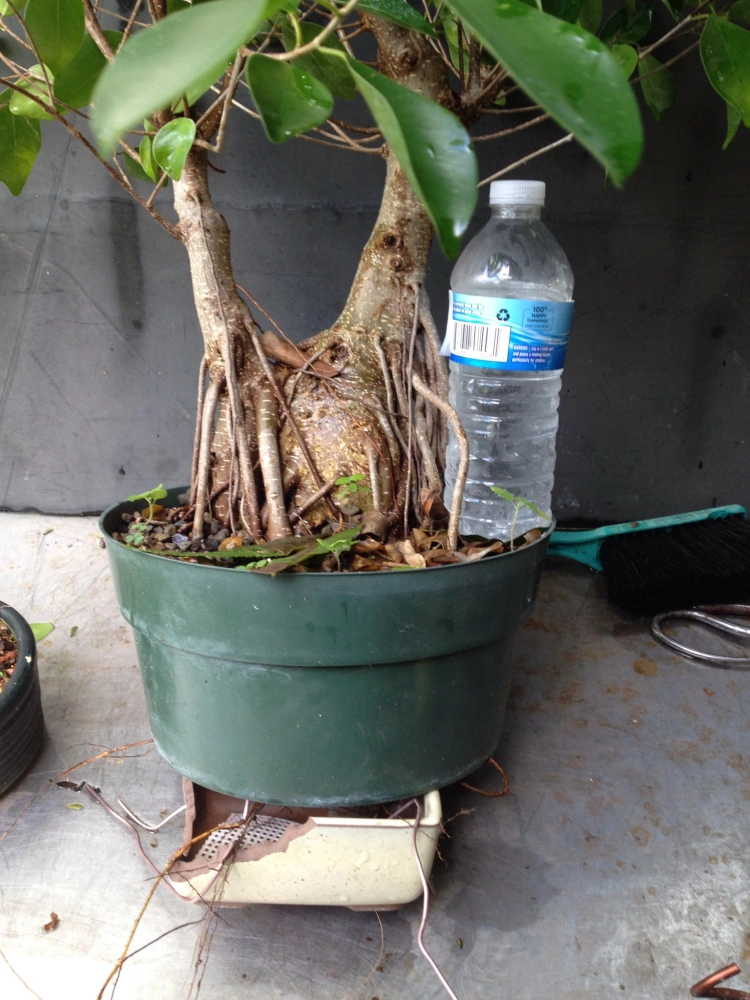
You’ll notice that the bark color changes to a light cream from the dark brown over time.
I like this “ginseng”. I’d say it’s about 20-30 years old.
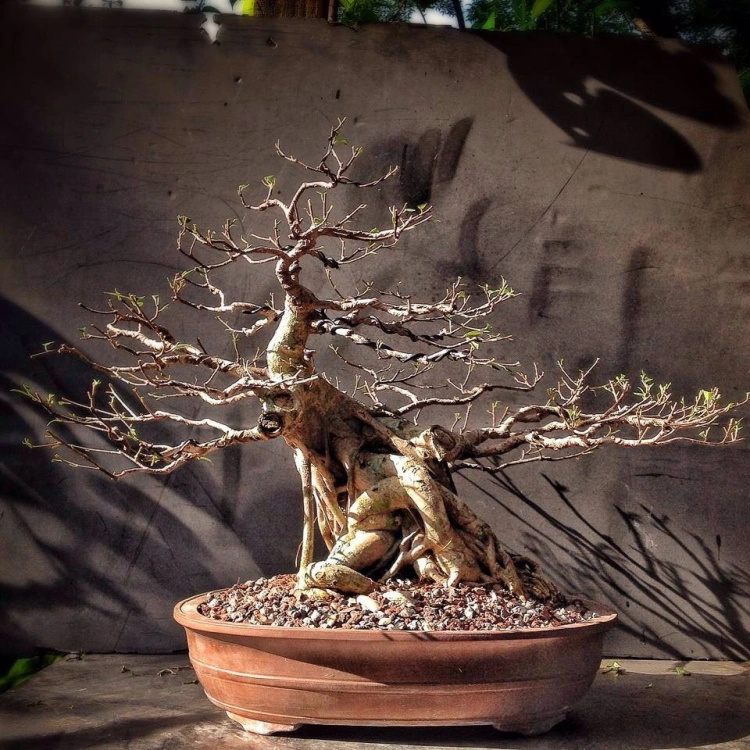
My favorite, Bigfoot, a ficus microcarpa with the same leaf shape as the ginseng.

Eighty, ninety years old at least.
If those last two trees don’t convince you that a ficus microcarpa can become a good bonsai I’m not sure what you consider “bonsai”.
Tree in a pot designed to resemble a natural tree (somewhat stretching the definition with some junipers out there but..), can be pruned, wired, styled etc., so that the branching and foliage is in scale with the size and design of the tree.
Is that bonsai? How easy is it to create bonsai using “ginseng”?
I’d say that ficus microcarpa is about the same difficulty level as a trident maple, all things equal. I grow both. The ramification, the trunk growth, the leaf reduction, the budding back; these all are pretty much the same with the two trees.
Anything else?
How about we go back to this tree and let me work on it?
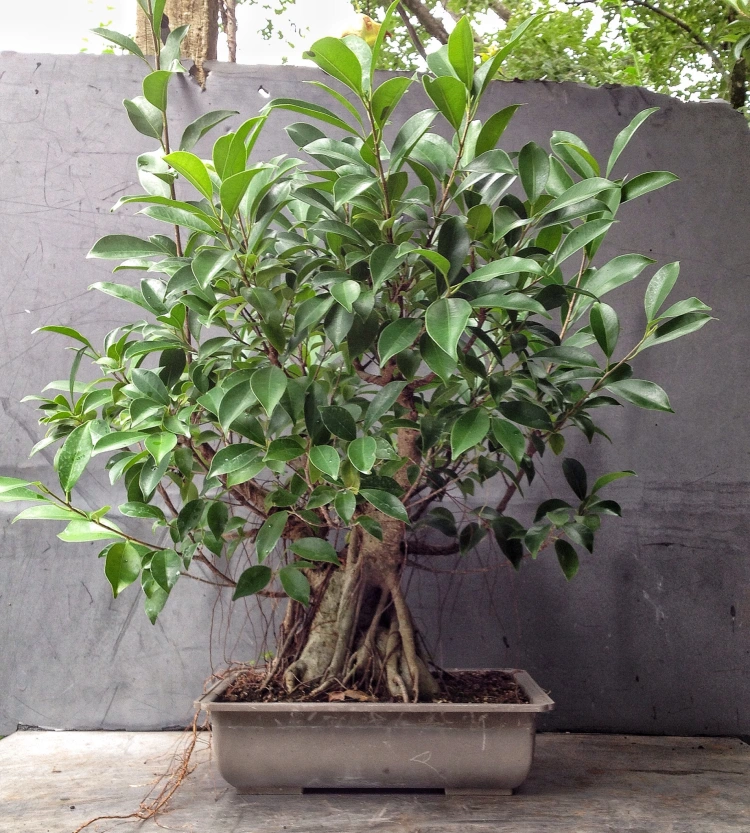
Let me show you instead of tell you.
This was how I received the tree a few years ago.
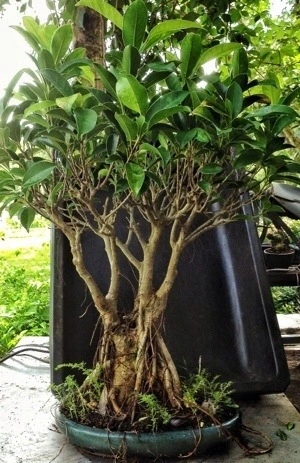
It was a “ginseng” at one point, the man who I bought it from told me the story of how he got it. It was then that I first suspected that a ginseng ficus was just a seedling f. microcarpa.
The man’s story, along with seeing real seedling ficus at Jim Smith’s nursery, being grown by Jim Van Landingham, are what confirmed it.
All of the seedlings Jim V was growing had caudex-like trunks.
Much like these two seedlings I found growing in some ficus I got at Old Florida Bonsai.
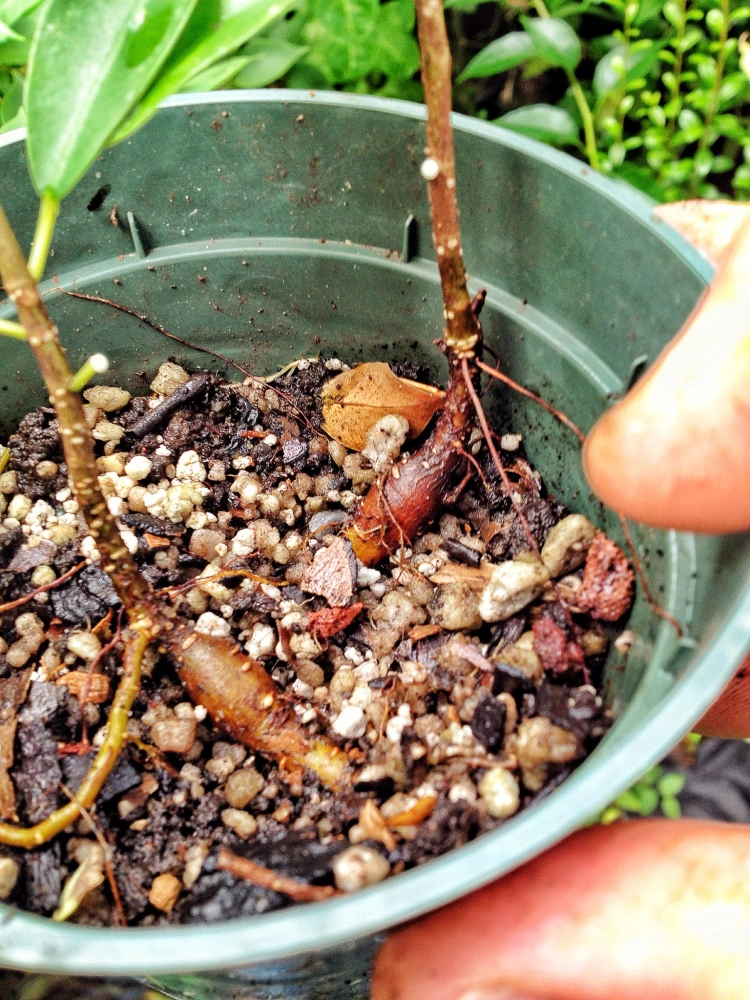
That’s right, vindication!
Why? It’s because Richard Turner doesn’t grow or sell ginseng ficus. He either collects trees from the wild or grows from cutting/seed. He doesn’t import at all.
So now we have the “Aha!” ficus, what did I do?
I chopped it back, of course.
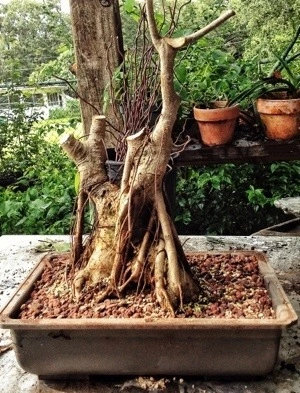
Then I let it grow out and I, yep, you guessed it, chopped it back again.
And wired it.
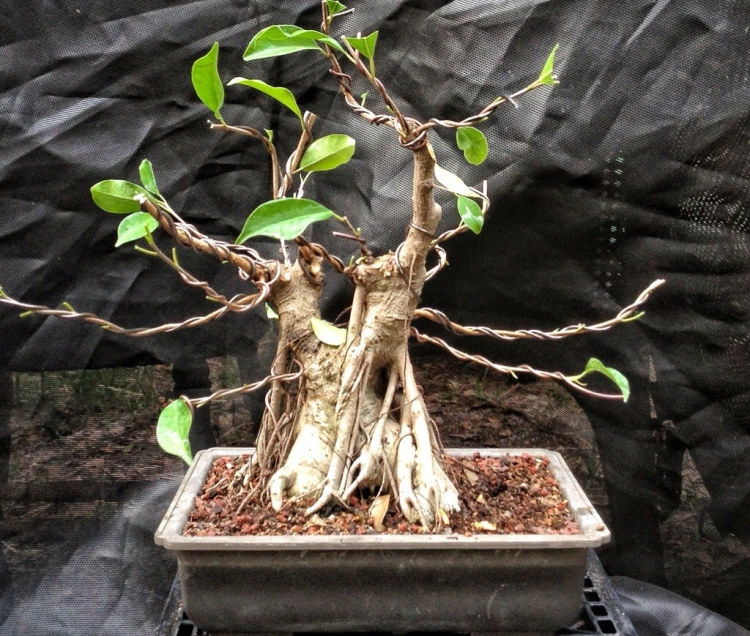
At this point I also drew a picture of my final goal for the tree.

You’ll see how far I’ve come at the end of this post.
The first step is defoliation.
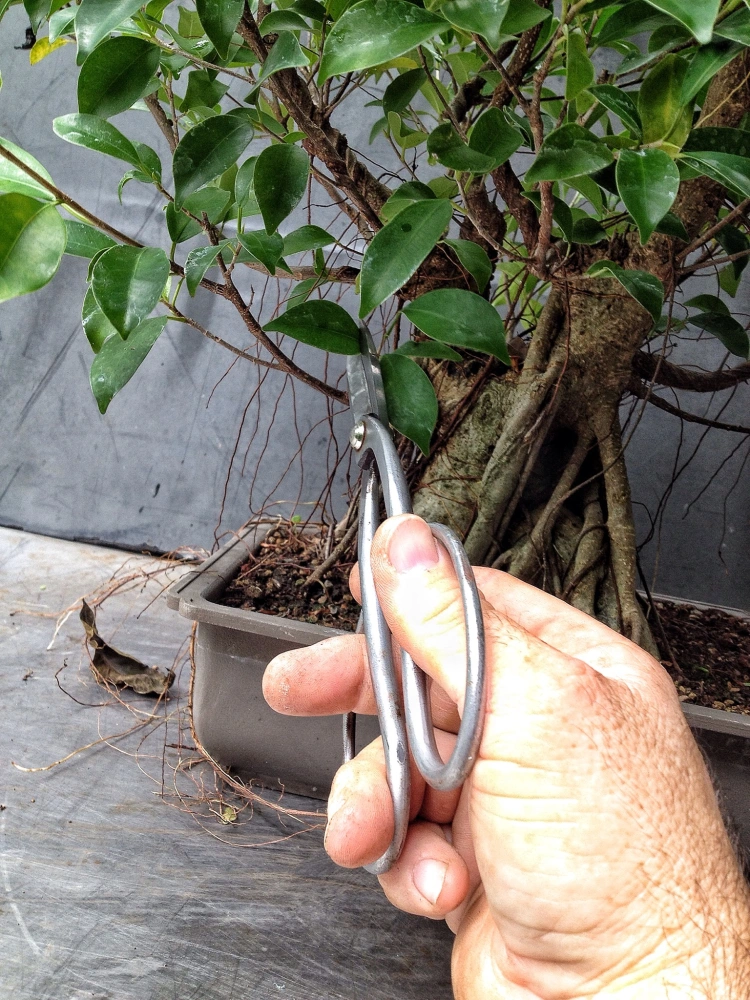
Let me clarify why I do this and why you should defoliate a ficus too (it seems that people skip over the “why” parts a lot and then misrepresent my work).
First reason: it let’s me see the tree.
Second reason: I will be wiring. Leaves get in the way.
Third reason: I am repotting, if I don’t defoliate, the leaves will fall off anyway, repotting and defoliating at the same time stimulate the tree to grow faster than doing each one seperately.
This I have experience with.
Now, we are talking ficus. Not elm, not maple, not hornbeam etc.
A tropical tree, of which most (not all) respond the same way, especially bougainvillea but not Serissa or bucida spinosa. Or Fukien tea; let them drop their leaves by themselves (which they do whenever you change anything about them, especially moving their location, like from the nursery to home).
Back to the ficus.
It’s begging to be repotted.
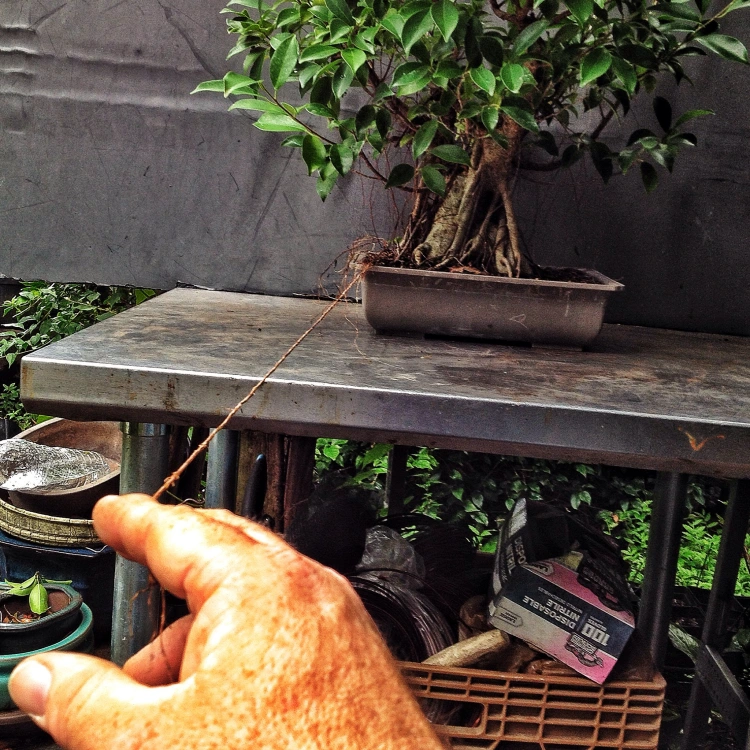
I can do this now, I’ll have at least a month of minimum nighttime temps of 60f or higher (it is late September) . I don’t bring my trees inside for the winter like many colder climate bonsai people do, so I have to be careful with my timing. I’ll have nights that get to 33f where I won’t protect the trees. Such is the Florida bonsai life.
If whatever winter protection you use can assure above 60f temps, go ahead and repot now. Just remember that you still need light to stimulate growth.
Speaking of light.
This is the front of the tree, which is also the side facing the sun.

This is the back, or shady side.

This tree was shoved into the greenhouse with most of the back shaded.
What do you see?
More aerial roots on the backside.
The front got more water (higher humidity) but more sunlight. The back got less water (lower humidity) but less light. Can we make a conclusion here? Just maybe.
Now, where was I?
That’s right, defoliation.
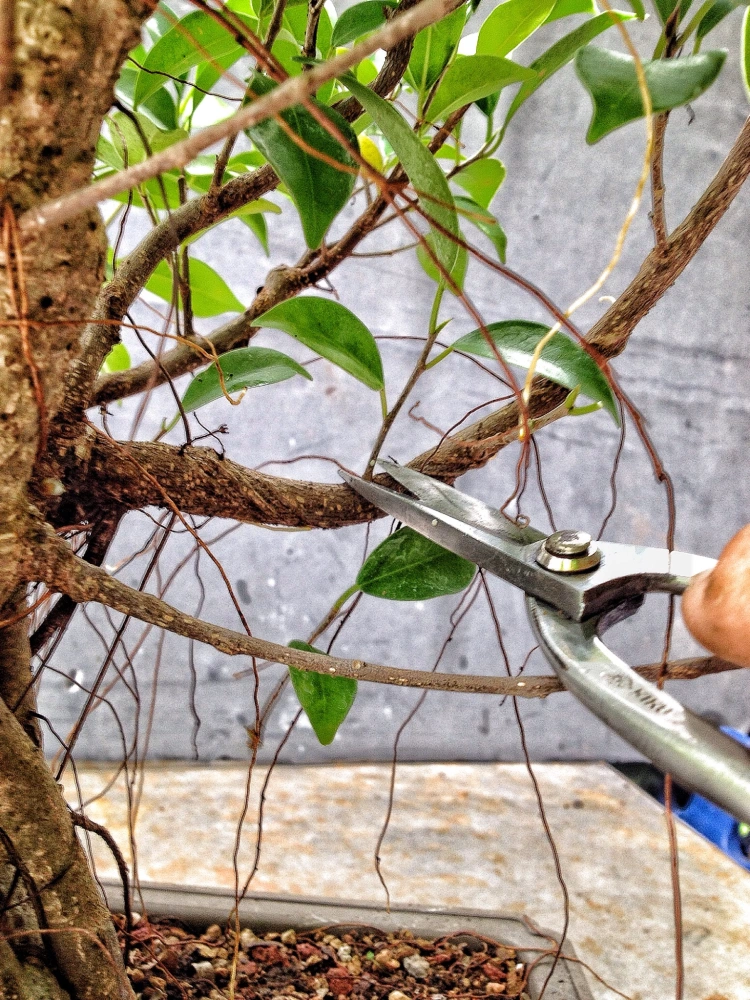
I’m also removing the unwanted new shoots, like the one growing straight up on the above pic.
Cut the leaves, strip the foliage, make the tree naked, cut, snip, snip, cut……
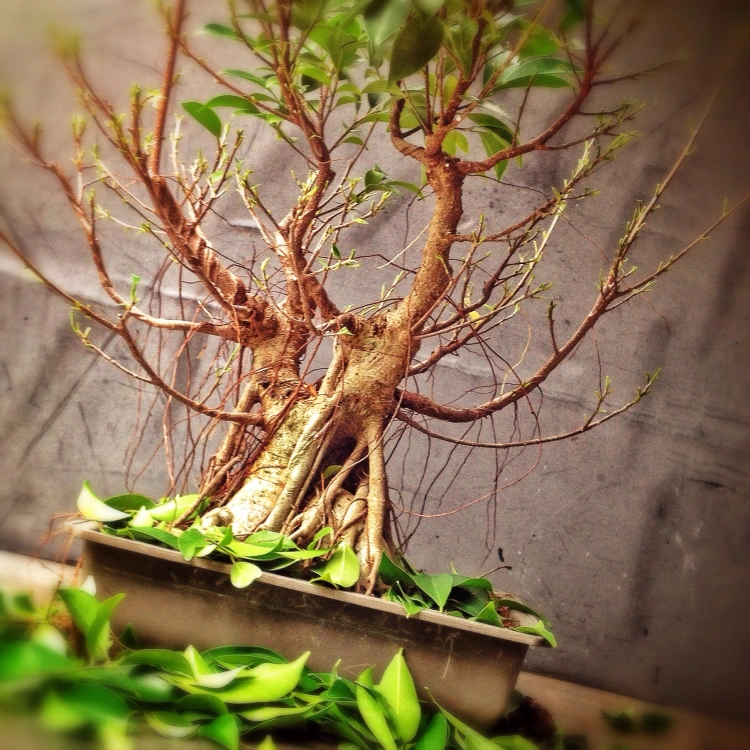
Uggggh, it’s endless….who said that these trees didn’t have dense foliage.
Ok, finished.
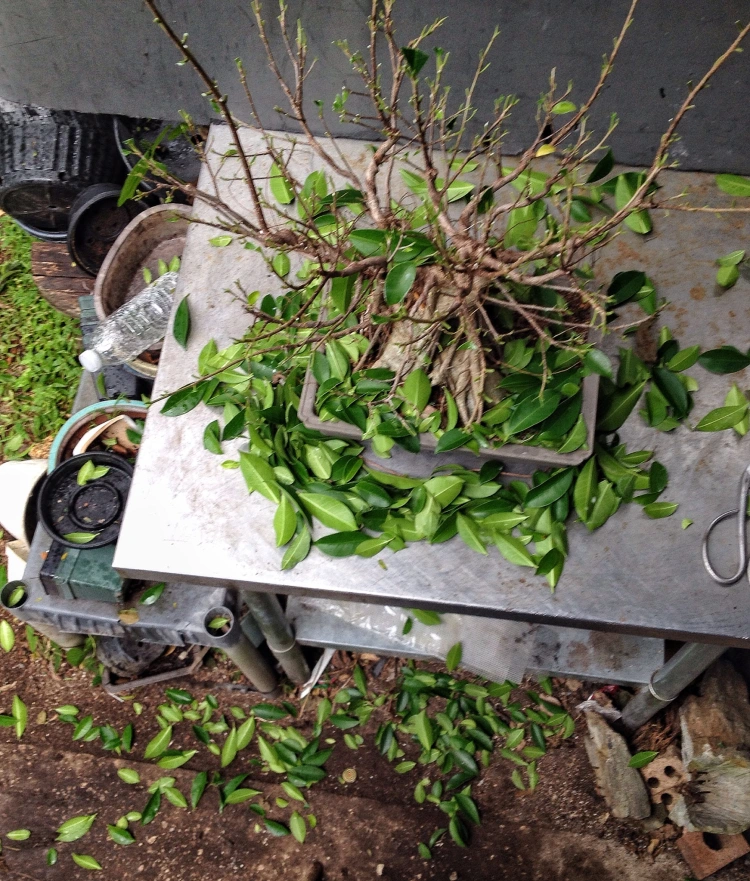
Where’s my broom? Damn it, who stole my broom?!
Now what’s my next step?
I’m going to prune for taper.
This branch is too big.
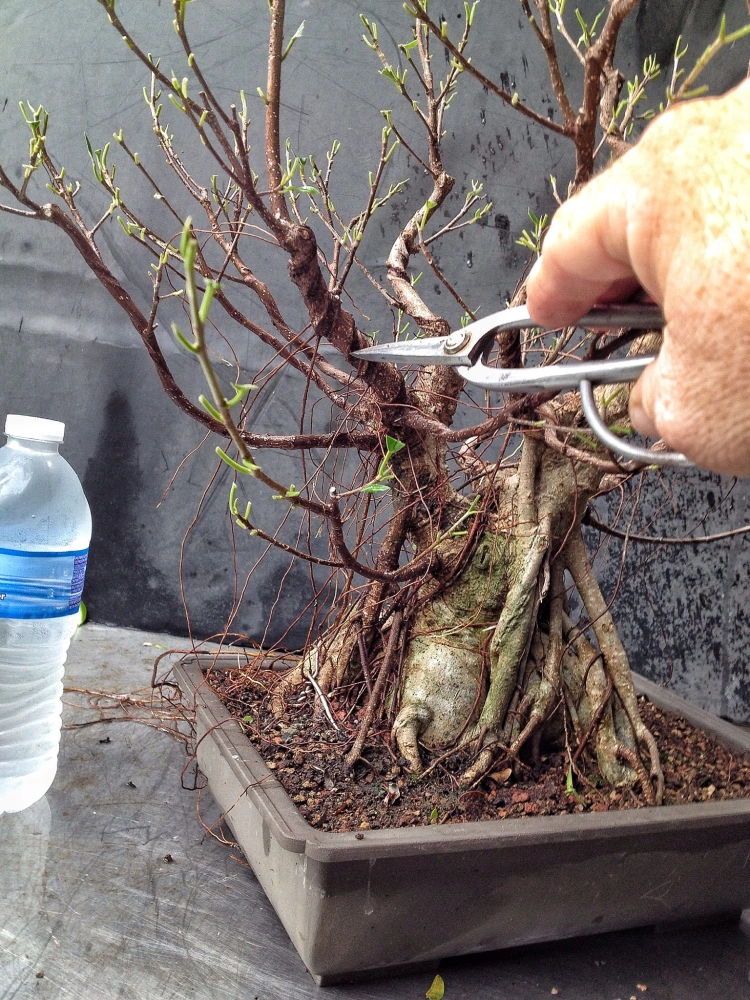
And the apex is a bit tall with some branches lacking taper.
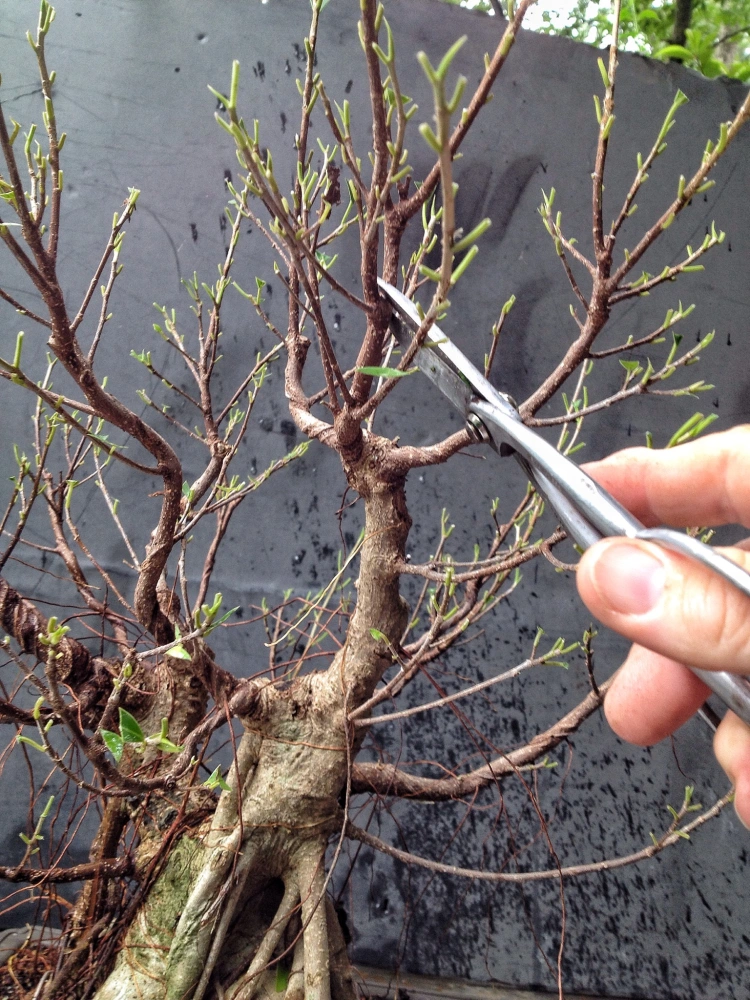
Chomp.
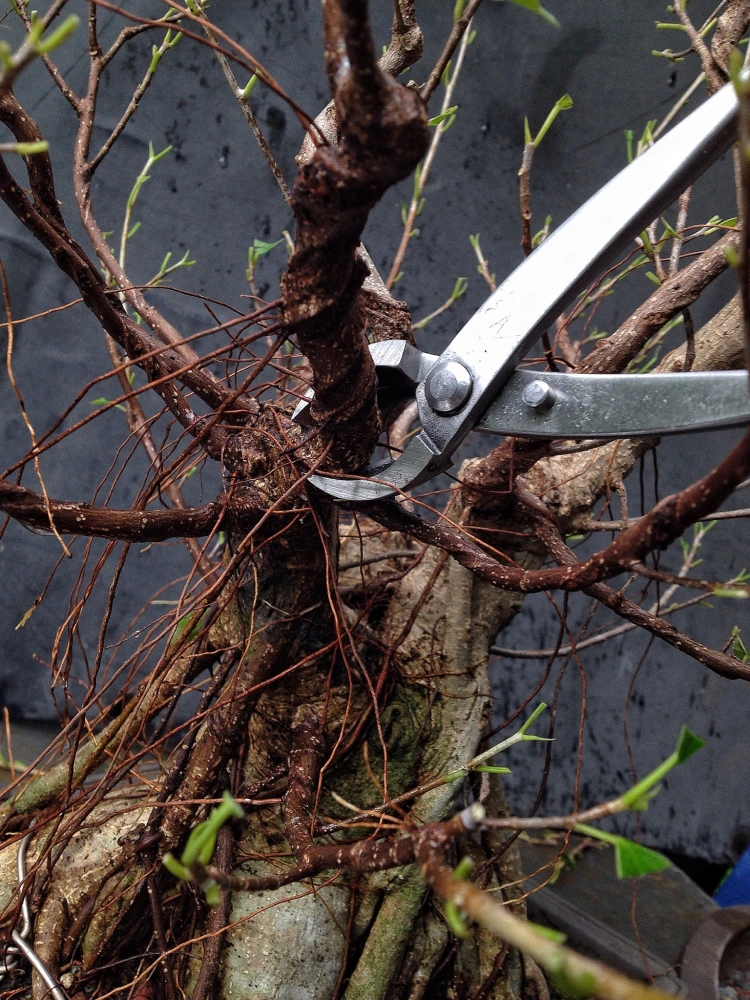
That will make a good cutting.
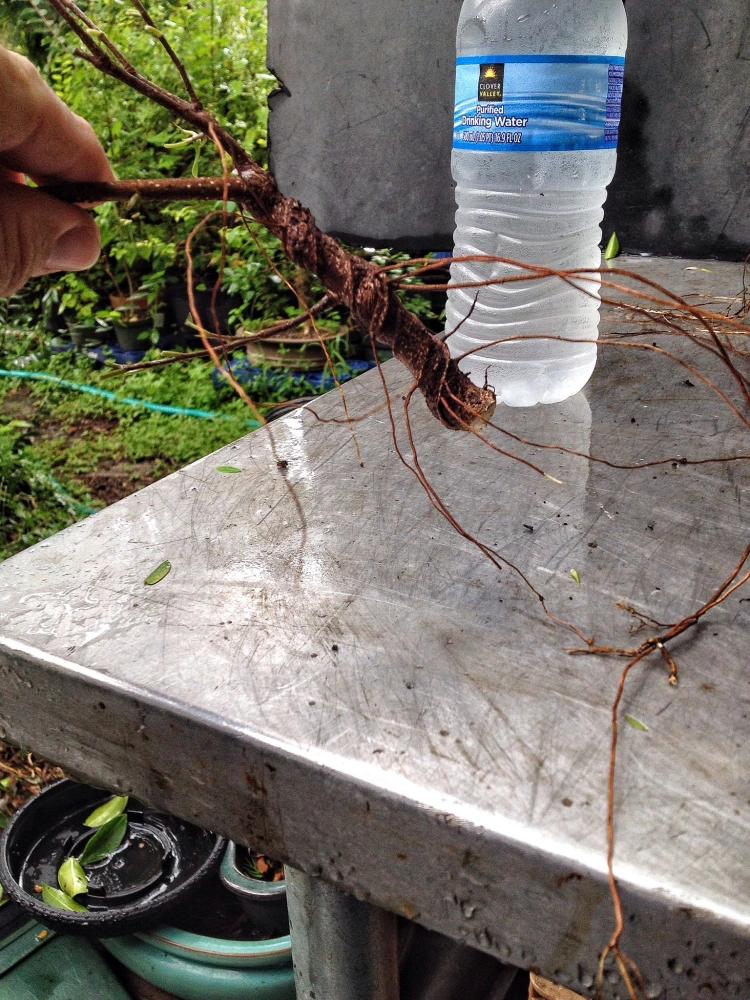
Next step, repotting.
It needs it.

With a ficus you should do this about once a year.
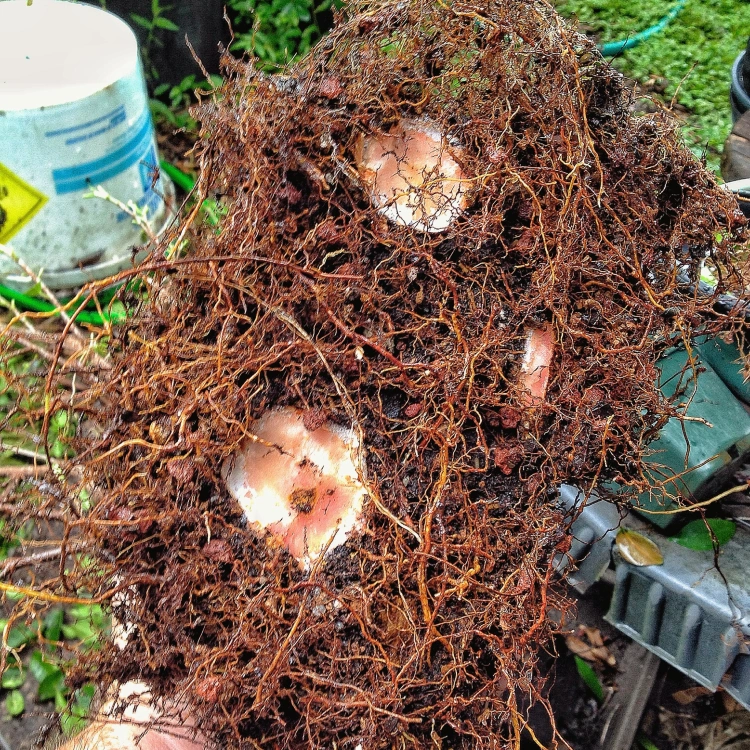

I rotated the front of the tree about 15 degrees counterclockwise.
Establishing shot.
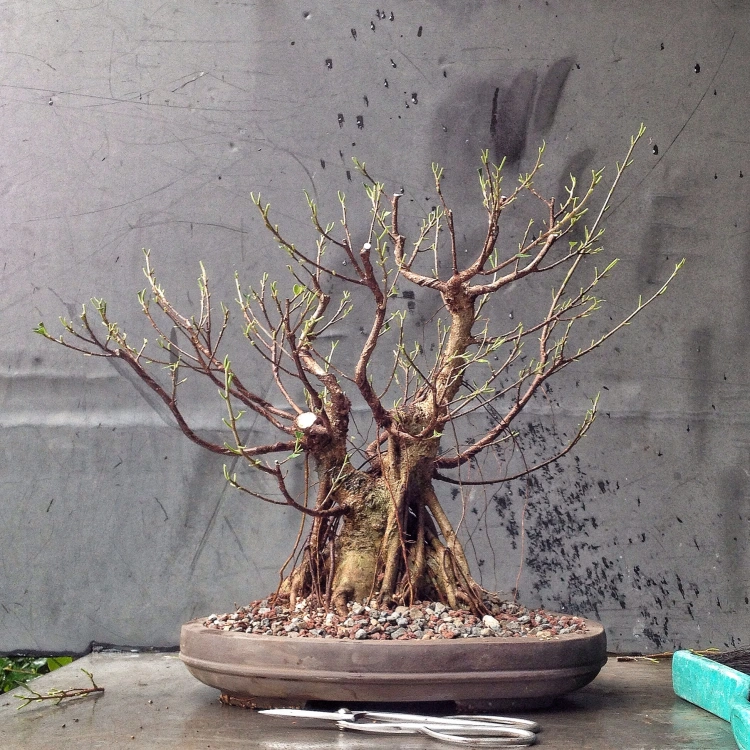
Wire time!

I do believe I’m making progress.
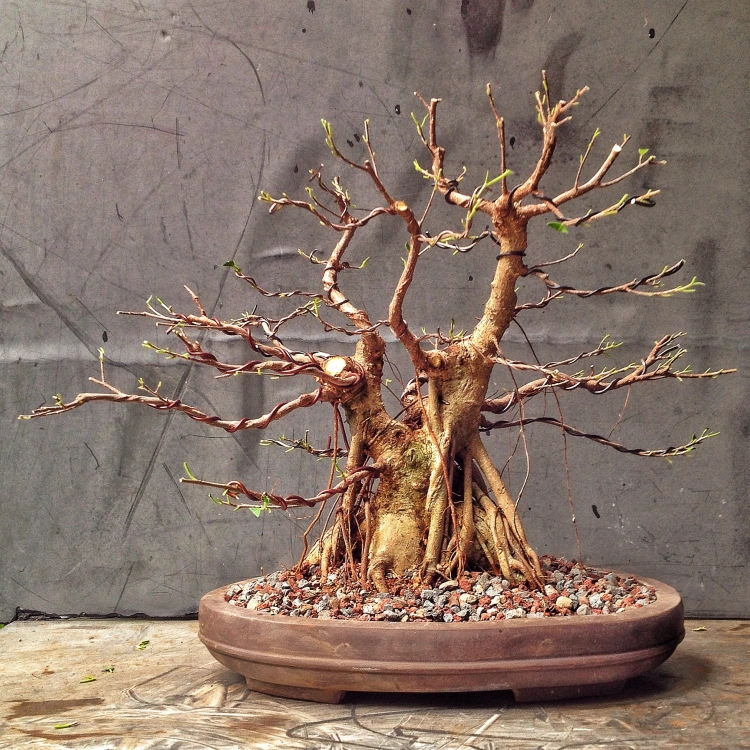
It looks like a banyan-style bonsai to me.
The Japanese don’t consider the banyan-style to be one of the “classic” styles or ficus as proper bonsai (even though Kimura has a ficus microcarpa “retusa” in his collection) but it seems to me that, with the waning of bonsai in Japan and the waxing of it in the rest of the world, the Japanese may just become another voice, and not the authority, on what species we use for our art.
To summarize (since about 2/3rds of you only look at the pictures)
The so-called ginseng ficus is a seedling ficus microcarpa that has had it’s caudex-like roots raised to artificially make the trunk look bigger.
It can be grown out (or air layered or cut down) to make it look more tree-like.
This process takes time, like all bonsai development does.
Only half of the ginseng ficus have grafted foliage.
And most importantly, be nice to beginners. We need more people in the hobby, business and art of bonsai. By calling their tree (whether it be a juniper mallsai, an S-curve tree, a twisted shimpaku or a ginseng ficus) a piece of crap and saying it’s not real bonsai is either just ignorant, or stupid. You choose.
We have a name for trees that haven’t been developed yet, how about we use it; PreBonsai.
“Sorry Fred, but, ya know, junipers of that size need a little more growth in them before they can be called proper bonsai”
” Wow Cindy, that ficus needs about 5 or 10 years of growth before the trunk looks like a tree, if you want it to look like a bonsai”
And when these new people say
“isn’t a bonsai just a tree in a pot?”
You say,
“Bonsai is actually an art form using small, living, relatively young trees and shaping them to look like large and old trees, employing the principles of line, form, dimensions and scale to create that illusion. Much like how a landscape painting has a sky and trees or mountains and a portrait should have a face, a bonsai should look like a tree”
And that should be that.
It won’t though.
It feels a little like a Peter Warren blog doing this here but, to quote:
People are people
So why should it be
You and I should get along so awfully
So we’re different colours
And we’re different creeds
And different people have different needs
It’s obvious you hate me
Though I’ve done nothing wrong
I’ve never even met you so what could I have done
I can’t understand
What makes a man
Hate another man
Help me understand
Help me understand
Now you’re punching
And you’re kicking
And you’re shouting at me
I’m relying on your common decency
So far it hasn’t surfaced
But I’m sure it exists
It just takes a while to travel
From your head to your fists
-Martin Gore, Depeche Mode-
Peter would link to the song though.
Aw hell, here you go http://youtu.be/ErnMC7xokQ8

Adam,
Thank you for running this blog. I have been reading (reading!) all of your posts since I got into this bonsai thing in the spring and found your blog. And when you didn’t post, I’ve been reading through the archives. You seem to be a fountain of knowledge and good humor and I have been meaning to thank you for sharing all this for quite a while.
I have never taken offense from things I’ve called or told angrily on the internet, but nevertheless I think you are addressing something important in your rant about the tone on certain forums. The reddit forum is a great place to go to when seeking advice and help of specific problems, that is, once you have established an idea of what bonsai is. I can understand why long time user of the site gets tired of the endless posting of prebonsai material, but that is never an excuse to be rude. I hope you manage to raise some attention to this with these two posts of yours.
I’m looking very much forward to seeing what you’ve got up next. Thank you again for all that you share – I hope I can visit your garden or a show of yours one day, I’m quite certain that would be an experience of proportions!
Until I make my way across the globe, be good!
Best wishes from Copenhagen, Denmark.
LikeLike
Thank you Jonas, it’s amazing that I’m reaching all the way to Denmark with my blog. I do hope to meet you one day my friend.
LikeLike
Well you are reaching Denmark loud and clear. I’m from the other end of the country from Copenhagen though.
Been interested in bonzai for a while (visually), but only just recently started pruning on my jades to see their reaction. Eventually I would like to go further and recently I bought a house with a garden so things are finally shaping up. Unfortunately the summer is almost over so it will probably have to wait for next year.
Been reading your posts for a couple of months and a thing that struck med is how you are extremely award og assisting us newcomers. Thanks for that 🙂
LikeLike
Hi, best wishes from Poland. There you are too!
LikeLike
Thanks for all of your comments. I am a 15 year beginner, and for many of the reasons you articulate, I often refer to my trees as Potensai… Maybe one day I will call a few of them Bonsai.
LikeLike
The use of “STFU” seems unnecessarily harsh in this setting.
LikeLike
I published it and then changed the title. Only the subscribers got the original title, of which I apologize. If you look back you’ll see the title has been changed
LikeLike
much better-
LikeLike
Nice.
LikeLike
Your blog is great. The last two posts are great reading. I know I’m not alone in saying that the open hostility toward beginners is the reason I don’t participate in the “popular” online bonsai forums. We have to look elsewhere and are lucky enough to find you.
The “intermediates” you speak of suffer from something called the Dunning-Kruger effect (worth a google).
LikeLike
Interesting theory! Thanks for the term
LikeLike
I recently got what appears to be one of these at Sam’s. It has since started to drop leaves like crazy. Some branches have been completely denuded and appear dead. Any advice?
LikeLike
Is it outside? How often are you watering it? Does it still have the rocks glued on top of the soil?
LikeLike
It was in my atrium but now it is now in an enclosed porch. I water it when the surface feels dry and it never had any rocks.
LikeLike
Outstanding post.
I’ll debate you on the Japanese fading. To use a car analogy, the classic Japanese bonsai is the Model – T, the Duesenburg, the Chevy with tail fins. Kimura drives a Shelby Cobra. Artists outside Japan are experimenting with Prius, Tesla, and Harley-Davidson as well as hotroding the Chevy and Dodge. The art evolves and changes. The Japanese classic style will probably stay best portrayed in Japan. When it travels internationally, we play with it.
LikeLike
Good analogy
LikeLike
Adam
I have read with enjoyment your blog for the last 3 years , but never have I enjoyed a posting more than the last 2 on “ginseng” ficus. As you know I am still a novice and have discovered that most self appointed “experts” probably know little or less than I do. I happen to have 2 ginseng ficus that I have maned “Running Man” because the exposed roots look like a pair of legs… right now I am just topiary pruning it for shape. Then other one I call “Poo Man” for obvious reasons when you look at the exposed roots. The point is that they are in the ficus family and will make an enjoyable bonsai in a couple of more years the I picked up in a box store on sale for under $15.00. I paid more for the pots I have them in. If I did not have some great teachers like the ones we know teaching and showing me I never would of had a tree at Epcot and have the collection I have now if I would have listened to the “Experts”and done what they said. Adam I enjoy your “rantings and ravings” because you have the makings a a great master and I want to learn as much as I can in what little time or should I say bonsai time I have
Thanks
LikeLike
Thanks Mark, I appreciate your words more than you know.
How have you been by the way?
I’d love to see the “Poo Man” one!
LikeLike
Adam great posts.
LikeLike
Adam, Love your blog. REad everyone of them. I too have been playing around with a “gensing” ficus this summer as an experiment. This thing has gone crazy since I got it out of the glued on rocks and peat moss it was potted in. Back budding all over the place. Just crazy. It will be interesting to see where it goes over the next couple of years. I have a question about another item I saw in your post above. The Ficus big box store “column” if you will with the leaves and branches all at the top. I have one of these that I “inherited”, a Ficus nitida. It has great large trunk flare, air roots, etc, but is about 6 ft tall and nothing green for the first two thirds of the plant. Just trunk. If I trunk chop this thing to use the great nebari and large trunk, will it back bud and put out new growth or just die back? I have heard both opinions on the possibility of a trunk chop. Love your humor man! Keep it going! Great laughs and great learning! Charles in Georgia
LikeLike
Send me some pics by email (adamaskwhy@yahoo.com) of the leaves, trunk etc. I don’t want to tell you used without seeing it first.
Thanks
LikeLike
Reblogged this on Wolf's Birding and Bonsai Blog.
LikeLike
I adore all plants. I used to try to grow things BIG – now I’m ready to learn the art of growing them small, artfully, intentionally. YOU have inspired me through your humor and massive amount of knowledge, to play with my green thumb in a new way.
THANK YOU.
From a complete – day 1 beginner!
LikeLike
I didn’t understand half of the technical stuff! But I have to say that there were some very striking bonsai in your photos 🙂
LikeLike
Thank you!
LikeLike
I found your blog around April 2015 – this will only be my third growing season doing bonsai, but the addiction hooks are set deep. I have read several posts previously, but now I finally want to thank you for the effort and the quality of information you provide. I have learned very much from you. In the case of my ginseng (given as a gift now that people know I do bonsai, sigh), I can’t plant in/on ground because I Iive in Philly area, but I have mine in a large training pot and am planning to just let the tree grow like hell…just have to figure out how to accelerate the aerial root formation. I’ve read that potting in a shallow pot where the roots fill the substrate quickly is important so the tree is stimulated to grow more roots aerially…but that goes against potting up so the tree can get overgrown and more tree-like…any advice? If not, thanks anyway! I’ve already garnered enough in my lurking to be indebted…
LikeLiked by 1 person
It’s mostly dark that creates aerial roots. Put the tree into a big pot, maybe 5-7 gallons, but only fill it up halfway. Keeping the sides on it so the trunk is essentially in the dark but the top is coming out of the top. That should be enough soil for top growth and the sides will give the dark needed for aerial root growth
LikeLike
Love this article. We need more posts such as these. Im new to bonsai (im talking 2 months) but my interest in bonsai has spread like wild fire. I now have 7 pre bonsais in the making one of which is a ginseng ficus. I had no idea my gonseng ficus had this potential. Im developing ramification and in a few yrs i plan. To air layer the more attractive trunk, then i plan to do root cuttings and repeat the process
LikeLike
I was directed to your blog by another BonsaiNut member. I agree with others post in about this blog. Thanks for your outtlook and youtube videos as well as your since of humor has broken the ice, as a regular guy doing extraordinary things in the Bonsai World!
Another Newb..
LikeLike
Thanks for the great post, would you recommend cutting off the grafted part of a ginseng ficus? The original seems to grow more vigorously?
LikeLike
The original foliage is more vigorous and the growth rates will match the top and bottom if you do cut off the graft. But the foliage that is grafted is usually better. It depends on how the tree really looks as to whether I’d cut it off or keep it
LikeLike
Hello, thank you for the informative blog and the humor! I was gifted a grafted “ginseng” ficus and am planning on putting in my grow box with the following conditions:
Southern CT, zone 7
250W LED, 16 hours on every day
soil: 60% clay pellets, 40% bonsai mix
Terra cotta plant pot inside the grow box with a tray of water, more clay pellets at the bottom to increase humidity.
Personally, I like the bulbous bottom and it has some great aerial roots with a dramatic look, kind of resembles someone doing Tree Pose in yoga against a railing for support. I plan on leaving the grafted foliage and allowing it to just sort of grow out for the first few years. How can I encourage foliage growth from both grafts and the original trunk?
Thanks again,
L
LikeLike
Nice ficus, I am starting one that I got from a Wal-Mart. It has the big base or raised root. I hope to form it to a banyan style to cover the base with aerial roots.
LikeLike
Thanks for this. Love the information. It also made me think of people in my trade, I’m a chef. We have so many chefs that don’t allow for creativity in food that it boggles my mind. Anyway, thanks
LikeLiked by 1 person
You are welcome
LikeLike
This is awesome. Thank you!
Kathleen
LikeLike